Museo Casa de la Memoria (House of Memory Museum) is a museum in Medellín dedicated to honoring the victims of urban conflict in Medellín and Colombia. And it’s worth seeing this musuem to better understand the history of the city of Medellín.
The museum was created to contribute to the comprehension and overcoming of the armed conflict and the diverse kinds of violence of Medellín, Antioquia and Colombia.
In addition, Medellín’s Museo Casa de la Memoria is a place intended to give voices to Medellín’s victims of violence. Also it’s intended to provide a place to grieve, reunite, remember, and develop strategies to avoid future violence.
Reportedly 33 percent of the visitors to this museum are foreigners. And to my surprise, many Colombians I have talked to in Medellín including my Colombian wife and her family are not aware of this museum in Medellín. But we included Museo Casa de la Memoria in our list of the 12 best Medellín museums.

Side view of Museo Casa de la Memoria
History of Museo Casa de la Memoria
Research for Museo Casa de la Memoria reportedly started in 2006. This was four years after Operation Orion took place in Comuna 13 in Medellín.
Operation Orion was the largest urban military operation in the history of Colombia, which occurred between October 16 and 19, 2002, to end one of the last bastions of the country’s guerrillas.
A need for a museum was seen to honor the victims of this conflict. And creating this museum was part of the Victim Assistance Program created by Medellín’s Mayor in 2004.
The museum opened its doors to the public in 2012. And it is located in Parque Bicentenario, which is near the Pablo Tobón Uribe Theatre.
The museum has three floors. The first floor is space for temporary exhibits, the second floor is where the main entrance and permanent exhibit is located and on the third floor is this museum’s archives.
Students are free to use the Resource Center for the Activation of Memory, which contains the museum’s archives and an extensive library of investigative material.
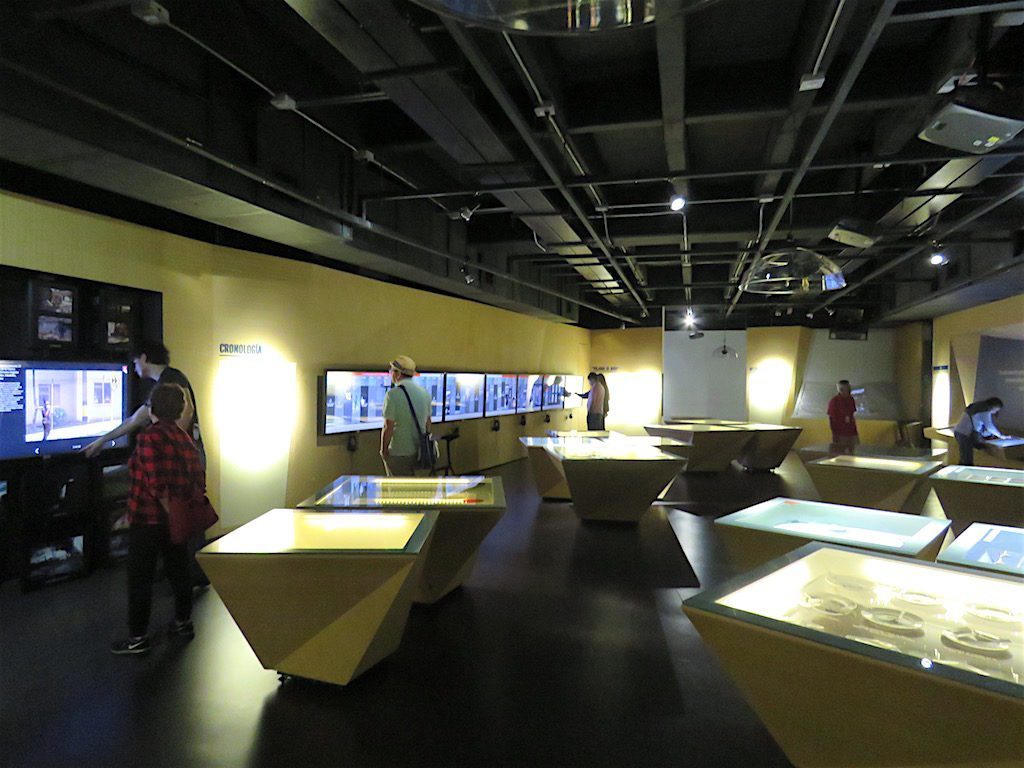
The permanent exhibit: Medellín: Memorias de Violencia y Resistencia
Permanent Exhibit: Medellín: Memories of Violence and Resistance
As you enter Museo Casa de la Memoria through the main entrance, there is a door to the left of the reception desk. This is the main exhibit hall for the museum and is the permanent exhibit: Medellín: Memorias de Violencia y Resistencia (Medellín: Memories of Violence and Resistance).
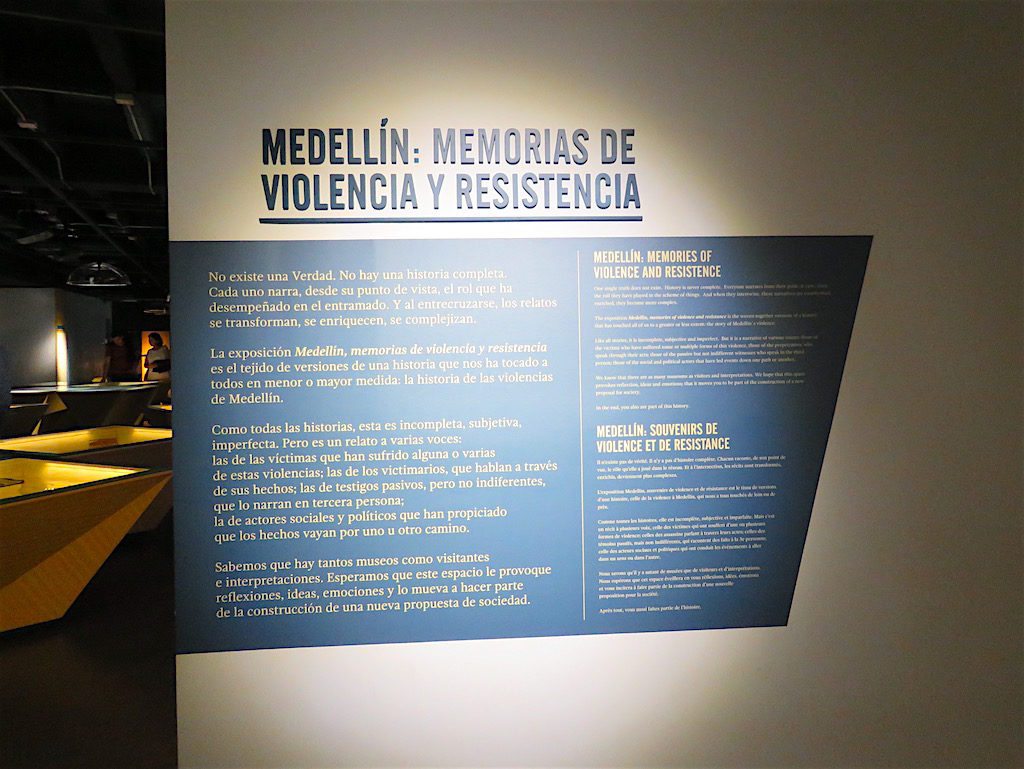
Medellín: Memorias de Violencia y Resistencia (Medellín: Memories of Violence and Resistance)
This exhibit tells the violent history of Medellín through a collection of voices and other means. There are newspaper archives, first-hand testimonials, audios, videos and artwork.
Also, there are several glass boxes dedicated to each actor involved in the armed conflict – schools and journalists, human rights activists, indigenous communities, women, etc.

One of the glass boxes – “between 1977 and 2013, 142 journalists and communicators were assassinated in Colombia”
In addition, there is a set of interactive screens that show a historical timeline and permit museum visitors to scroll through Colombia’s past and discover events have marked the country’s history. You can see video testimonies of victims of the armed conflict. And you can drill down to see relevant newspaper articles.
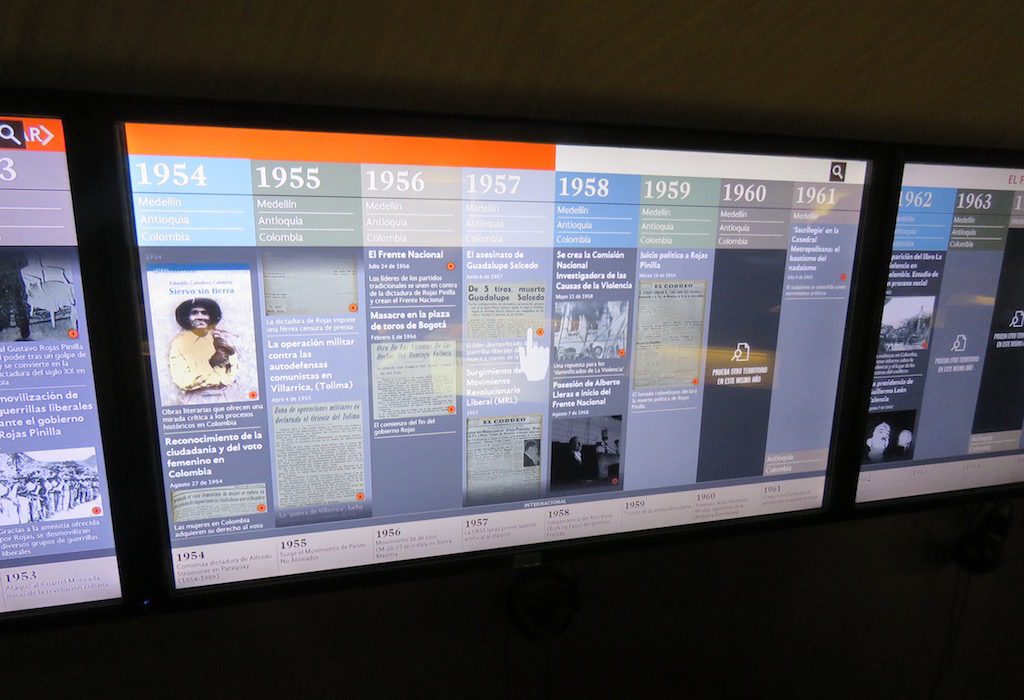
Interactive screens with a historical timeline

Drilling down to see newspaper articles about Pablo Escobar’s death
You could spend hours in this main exhibit, with all the comprehensive information from the beginnings of armed conflict to the present.
Temporary Exhibits at Museo Casa de la Memoria
At the back of the main exhibit hall are stairs leading down to temporary exhibits at Museo Casa de la Memoria. And these temporary exhibits alternate on roughly a yearly basis.
Currently there is a Medellín es: 70, 80, 90 (Medellín is: 70, 80, 90) exhibit. This exhibit looks at different periods that have characterized three recent decades of Medellín’s history.
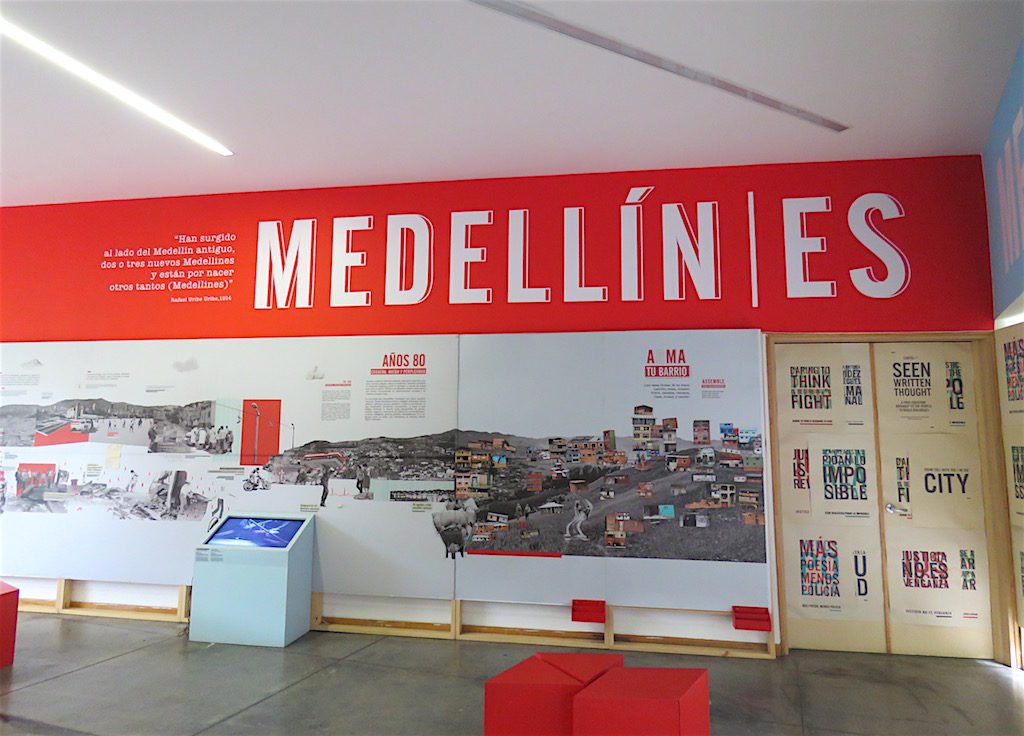
Part of the “Medellín es: 70, 80, 90” exhibit
This exhibit looks at some of the most troubled years in Medellín’s history to some initial glimmers of hope that started to appear towards the end of the 1990s.

Medellín was the most violent city in the world in 1991 with 6,809 homicides
Medellín was the most violent city in the world in 1991 with 6,809 homicides. But the security situation in Medellín has improved dramatically over the past 26 years. In 2017, reportedly 577 homicides occurred in Medellín. Medellín now has a homicide rate lower than is found in St. Louis, New Orleans or Baltimore in the U.S.
In addition, the maps and photographs of life in Medellín in the 1980s in this exhibit deserve a close look. It’s interesting to see the dramatic transformation and growth in Medellín over the years.

Medellín’s population doubled from 1964 to 1985
‘Geografías de la verdad’ is another temporary exhibit in the museum. This exhibit takes visitors on a trip around the interior and exterior of the museum. And this is on display until September of this year.
Reportedly the museum is currently working on a project called jugatori. This combines the notions of a playground and a laboratory. And it will provide a creative space for children to play and learn at the same time. This jugatori project is scheduled to be available by year-end.
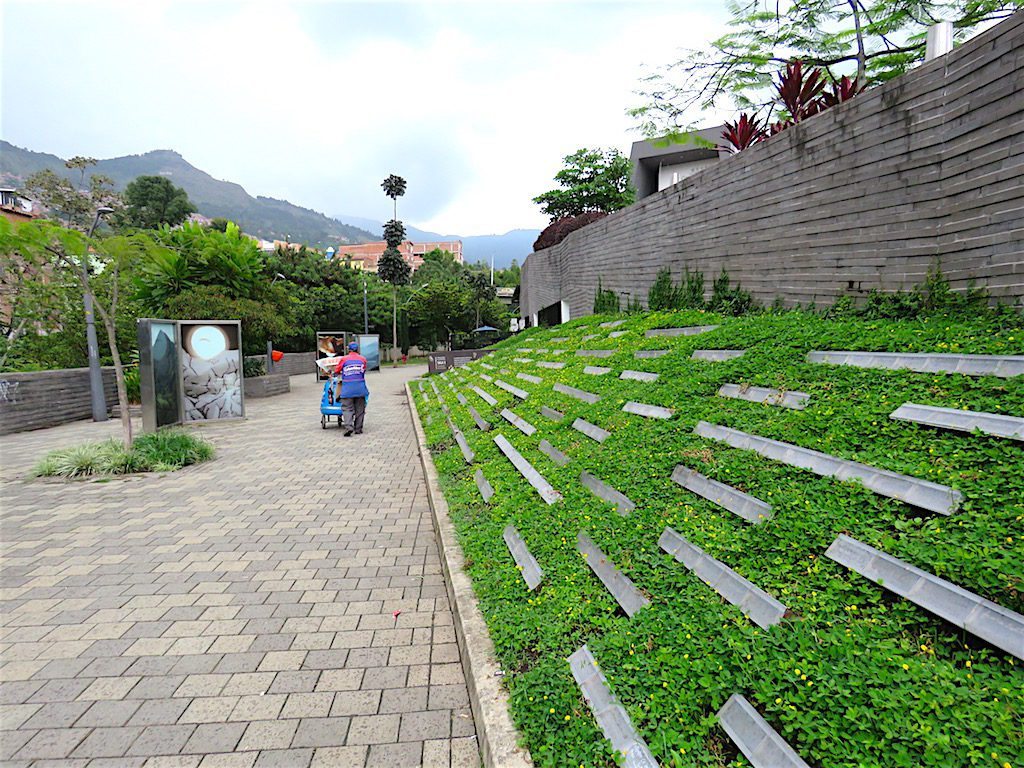
Conflict victims names on blocks on one side of Museo Casa de la Memoria
The downstairs temporary exhibits have exits to the outside. And along this side of the museum are blocks displayed with many conflict victims names.
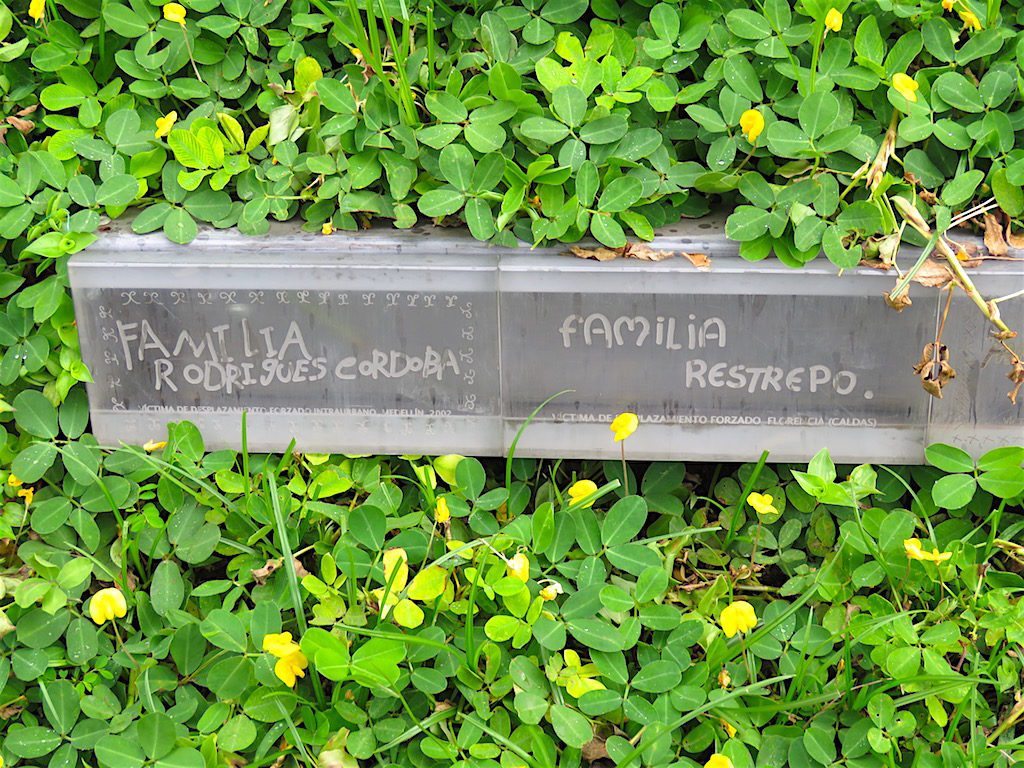
Some of the conflict victims names
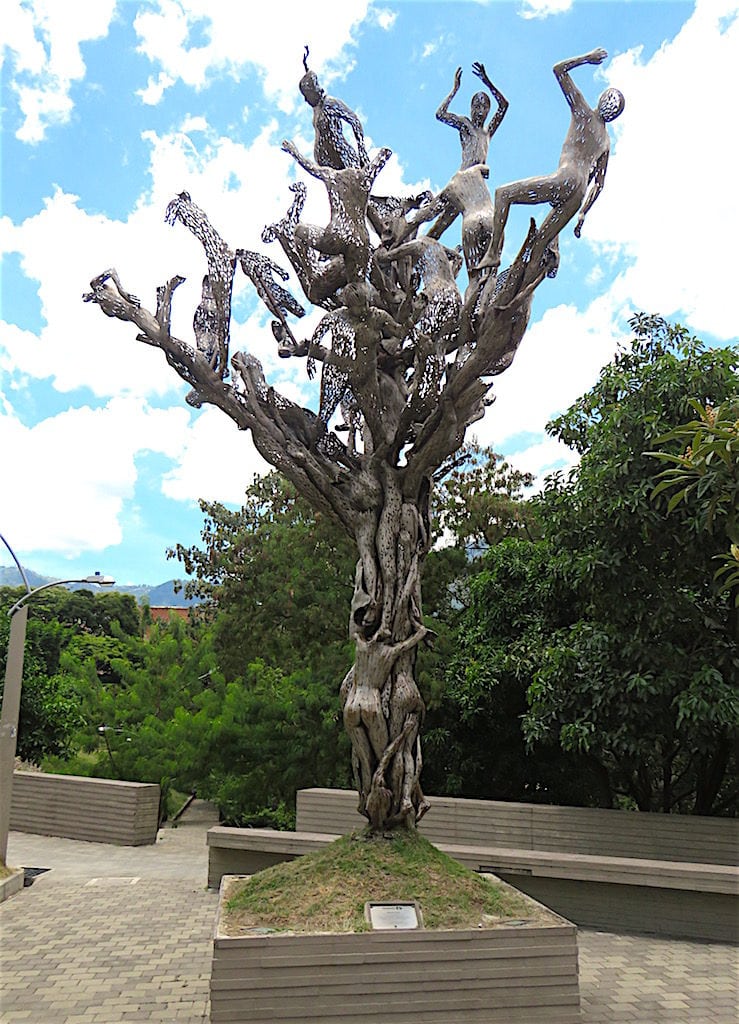
Tree of Life statue (Árbol de la Vida) near Museo Casa de la Memoria in Medellín. The statue was built with 27,398 weapons collected in disarmament processes in the neighborhoods of Medellín.
How to Get to Museo Casa de la Memoria
The easiest way to get to Museo Casa de la Memoria is via the Medellín Metro. To get there take the A or B metro line to the San Antonio metro station. And transfer to the T-A Tranvía tram line downstairs. Take the tram to the Bicentenario station. Finally, the Museo Casa de la Memoria is about a 5-minute walk north from this station.
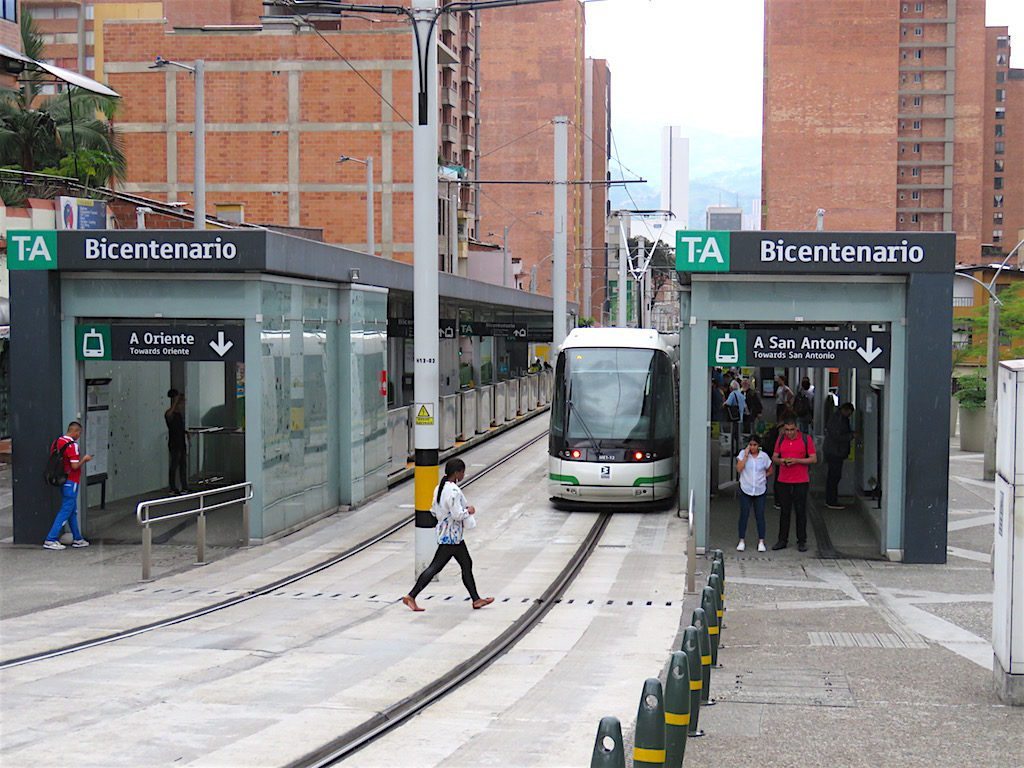
Bicentenario tram station
You can also get to Museo Casa de la Memoria by bus. In front of the San Antonio Exito in El Centro on Avenida Oriental, take the Caicedo bus routes 093, 094 or 095. And get off the bus at Parque Bicentenario.
It is also possible to walk to Museo Casa de la Memoria from El Centro. But it is about a 20-minute walk from the popular tourist spots of Museo de Antioquia and Plaza Botero in El Centro. It is not a 10-minute walk like I have seen some sites say.
In addition, most taxi drivers in Medellín will know where Parque Bicentenario is located. If not, give the driver the address below. And it’s also pretty easy normally to catch a taxi on the road outside the museum.
Furthermore, this museum is located near Mercado Del Tranvía – Medellín’s newest gastronomic market with 21 trendy restaurants, which is located less than a 10-minute walk from the museum. So, you could combine a visit to this museum with a visit to Mercado Del Tranvía.
Website: http://museocasadelamemoria.gov.co/en/
Address: Calle 51 #36-66, Parque Bicentenario, Medellín
Telephone: +57 (4) 520 2020
Hours: Tuesday – Friday: 9 am – 6 pm; Saturday, Sunday and Holidays: 10 am – 4 pm. Closed on Monday.
Entrance fee: this museum is free to enter and you can take photos without flash.
Guided tours are available in English on Tuesday and Thursday from 9 am to noon and 2 pm to 6 pm. Send an email to [email protected] a week before to schedule a tour.
Museums in Medellín
On the Medellin Guru website, we have looked at 17 different museums in Medellín:
- Museo de Antioquia – the most popular museum in Medellín, worth visiting. It’s best known for a collection of art of Medellín-born artist Fernando Botero.
- Medellín’s Museo de Arte Moderno (Modern Art Museum) – worth a visit with an intriguing mix of exhibitions located in a striking building.
- Parque Explora – Medellín’s popular interactive science museum and aquarium. It has over 300 activities and the largest freshwater aquarium in South America.
- Jardín Botánico – Medellín’s free botanical gardens that is also considered a museum with over 1,000 different living plants on display.
- Planetario de Medellín – Medellín’s Planetarium and space museum that is very popular and worth seeing, particularly with kids.
- Museo El Castillo – Medellín’s beautiful Gothic-style castle that is a museum.
- Museo Cementerio San Pedro – a cemetery that is also a popular museum in Medellín worth visiting. It also has a church with many beautiful stained-glass windows.
- Museo Casa de la Memoria – a museum dedicated to honoring the victims of urban conflict in Medellín and Colombia and is worth seeing to better understand the city and country.
- Museo del Agua – the popular Medellín water museum.
- Casa Museo Otraparte – a hidden gem in Envigado consisting of a museum, cultural space and café dedicated to the life and works of Colombian philosopher Fernando González.
- Museo Universidad Antioquia (MUUA) – a Medellín museum located on the University of Antioquia’s campus with a huge collection of nearly 40,000 archaeological and natural history pieces.
- Museo Casa Gardeliana – a museum located in Medellín that is dedicated to tango music and musician Carlos Gardel.
- Pedro Nel Gómez Casa Museo – a museum located in Aranjuez that is dedicated to the life and works of important Colombian artist Pedro Nel Gómez who is best known for his extensive work as a muralist.
- Museo Etnográfico Miguel Angel Builes – a hidden gem museum in Medellín dedicated to showing the cultural diversity of indigenous and ethnic groups in Colombia.
- Rafael Uribe Uribe Palace of Culture – Medellín’s palace in El Centro is one of the most photographed buildings in the city. It’s considered a museum by the city of Medellín but there aren’t very many exhibits to see inside.
- Museo Entomológico Piedras Blancas (MEPB) – an insect museum located at the Parque Ecológico Piedras Blancas, which is an ecological park located in Santa Elena near Medellín.
- Museo de Ciudad – Medellín’s City Museum, which is located next to Pueblito Paisa. This museum has a scale model of the city and a photo exhibit with photos from the 1890s to about 1950 showing the history of the city of Medellín.
The 10 English-language Colombia guidebooks that I have are missing several of these museums. And each guidebook only includes six to nine out of the 17 museums in Medellín we have looked at.
The Bottom Line: Museo Casa de la Memoria
Museo Casa de la Memoria is worth visiting to better understand the controversial history of Medellín and Colombia.
The museum does a good job of documenting Colombia’s armed conflict. And it can help you understand how far Medellín and Colombia has really transformed over the past several decades.
The bottom line is that Museo Casa de la Memoria is a unique museum in Colombia. And I haven’t seen a similar museum in the other cities I have been to in Colombia. But Bogotá is building a Museo de Memoria Histórica that is reportedly scheduled to open in 2020.
Sign up for the Free Medellin Guru Newsletter – You can see all of the previous Medellin Guru weekly email newsletters and sign up here.

